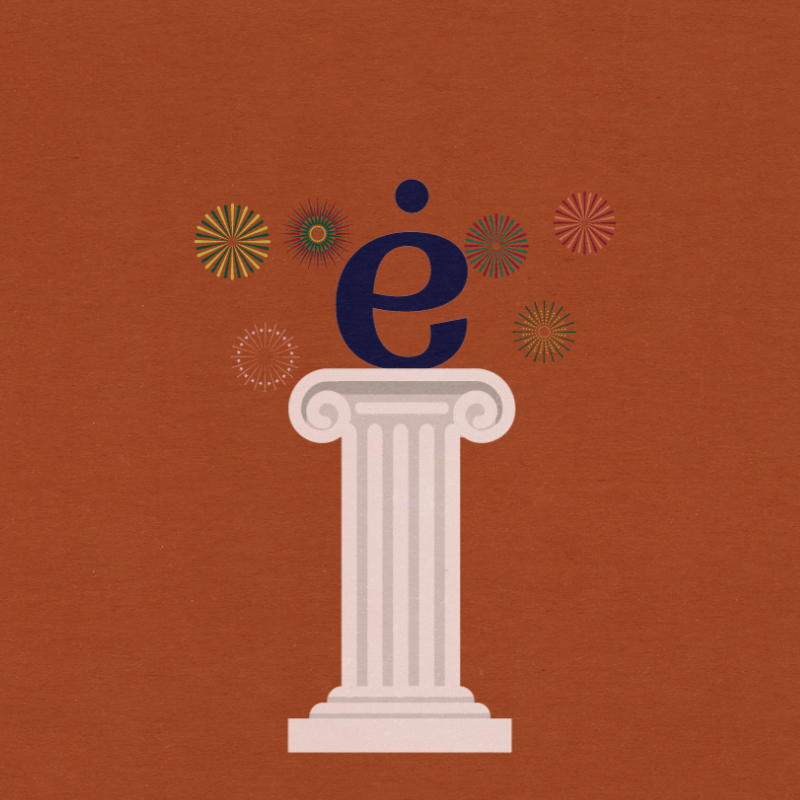The Lithuanian Alphabet, or How Lithuanians Created Their Letters
> BACK TO 100 STORIESThe Lithuanian alphabet – the alphabet is a list of the letters used to write words – was created at the beginning of the twentieth century. But discussions about the most appropriate alphabet for the Lithuanian language began a long time ago – back in the sixteenth century. Writers, linguists and enlightened people argued passionately about the Lithuanian alphabet. These arguments were intense, similar to current disagreements between strict language custodians and those who would like more innovation and fewer rules. This is understandable because language, like everything in this world, changes over time.
The first alphabet of the Lithuanian language was proposed by Martynas Mažvydas in Catechism, the first Lithuanian book published in 1547. Unfortunately, it contained only twenty three letters, which was not enough to record all the sounds found in the Lithuanian language. A similar alphabet to the current one was presented by Vincas Kudirka, a writer and one of the most important members of the Lithuanian national rebirth movement, in 1890. The Lithuanian alphabet was finally formed and consolidated by the linguist Jonas Jablonskis in The Grammar of the Lithuanian Language published in 1919 and 1922.
There was much discussion in the nineteenth century not only over the question of letters, but also as to which dialect should be chosen as the basis for the written language. These considerations came up because different places in Lithuania speak different dialects – the same vowels and consonants are pronounced differently, and the vocabulary varies. Finally, the southwestern Aukštaitian (Suvalkian) dialect was chosen.
The modern Lithuanian alphabet consists of 32 letters and three additional letters (q, w, x) are used to write words in other languages, such as the names of foreigners. Lithuanians took most of the letters from Latin. However, there are some letters that don’t belong to the Latin alphabet – ą, ę, į, ų, ė, č, š, ž, ū. How did these letters appear in the Lithuanian alphabet and why were they needed?
The Lithuanian alphabet almost perfectly represents the sounds of the Lithuanian language. This means that the word is usually written as it is heard. This is why the Lithuanian alphabet differs from the English or the French: many sounds are written one way and pronounced in another way in these languages, and some letters are written but not pronounced at all. New letters, which do not exist in the Latin alphabet, appeared in the Lithuanian alphabet in order to write Lithuanian words as accurately as possible. What are these letters?
The first Lithuanian writers took over the letters ą and ę from the Polish alphabet in the Renaissance era, and the letters į and ų were created by the example of the first ones. The letter ė was created by Lutheran priest Daniel Klein in the seventeenth century. It is a unique letter which cannot be found in any other language, so there are plans to build a monument for this letter in Kaunas. The letters š, ž, č were taken from the Czech alphabet in the nineteenth century. The most recent letter of the Lithuanian alphabet is ū, which was introduced by Jablonskis at the beginning of the twentieth century.
Although today everyone agrees more and less on the pronunciation and writing of Lithuanian words, arguments still happen. For example, there is discussion over whether the inclusion of the letters w, q, x would change the Lithuanian language. Some people think that some letters could disappear from the Lithuanian alphabet for example. It is often suggested that we should eliminate the letters which have the ogonek, because today we pronounce the sounds written by them in the same way as we pronounce the sounds written without them. For example, the letters ą and a in the word namą [Eng. house] are pronounced in the same way.

